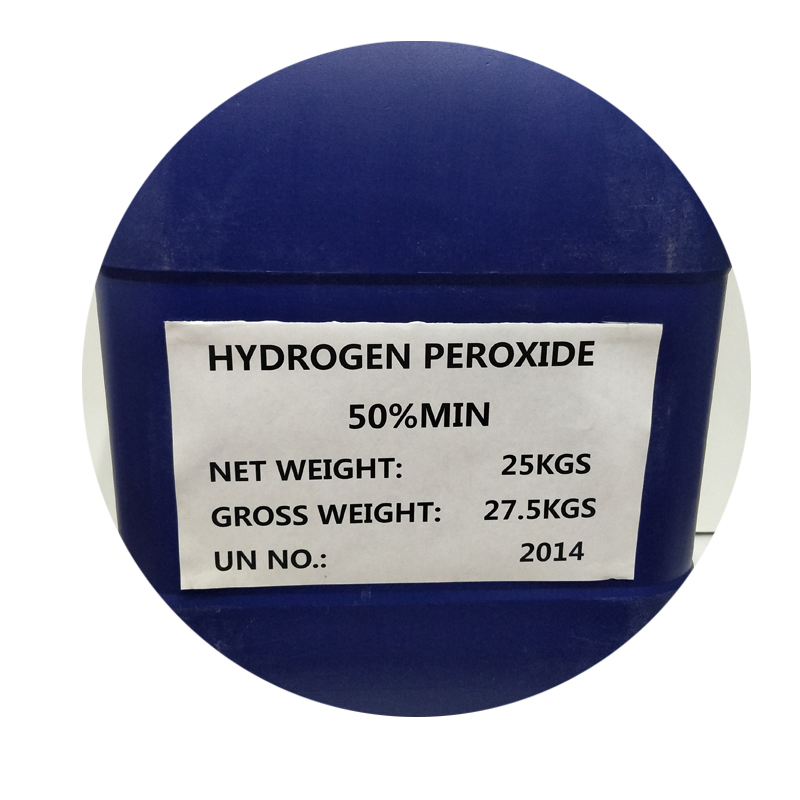Hydrogen peroxide

Hydrogen Food Grade H2o2 (H2O2) is an incredibly ubiquitous oxidant used as a reagent, disinfectant, antiseptic, and propellant. In
synthetic chemistry, H2O2 is used for epoxidation and hydroxylation transformations, and is used as the raw oxidant source for
generating more complicated and specific organic/inorganic Food Grade H2o2s. H2O2 in aqueous solution is used as a laboratory
disinfectant and as a topical antiseptic. Studies investigating the correlation between free radical oxidative damage and
neurodegeneration have utilized H2O2 to introduce reactive free radicals to cells and induce a model of oxidative
neurodegeneration. The oxidation potential of H2O2 has further been harnessed in bipropellant rocket fuel formulations. The
disinfectant, bleaching, and non-toxic properties of H2O2 provide a wide scope of industrial and commercial applications.
Tech Grade:
|
Item |
27.5% |
30% |
35% |
50% |
|
H2O2(m/m) |
27.5% |
30% |
35% |
50% |
|
(H2SO4)(m/m)% |
0.04 |
0.04 |
0.04 |
0.04 |
|
Evaporation residue(m/m)% |
0.08 |
0.08 |
0.08 |
0.08 |
|
Stability% |
97.0 |
97.0 |
97.0 |
97.0 |
|
(C)(m/m)% |
0.03 |
0.025 |
0.025 |
0.035 |
|
(NO3) (m/m)% |
0.02 |
0.02 |
0.02 |
0.025 |
Food Grade:
|
Item |
30% |
35% |
50% |
|
H2O2(m/m) |
30% |
35% |
50% |
|
H2SO4(m/m)% |
0.02 |
0.02 |
0.02 |
|
Evaporation residue(m/m)% |
0.005 |
0.005 |
0.005 |
|
PO4 2- (m/m)% |
0.005 |
0.005 |
0.005 |
|
As(m/m)% |
0.0001 |
0.0001 |
0.0001 |
|
(Pb)% |
0.001 |
0.001 |
0.001 |
|
Fe(m/m)% |
0.00005 |
0.00005 |
0.00005 |
|
Sn(m/m)% |
0.001 |
0.001 |
0.001 |
More specifically, applications of hydrogen Food Grade H2o2 - H2O2 can be defined in:
- Ecology
- Paper industry
- Textile industry
- Dairy (food) industry
Ecology
- Oxidation:
- formaldehydes
- phenols
- organic chlorine compounds
- decolouration of synthetic dyes
- reduction of chemical oxygen demand
- organic effluents
- Extra oxygen intake:
- biological treatment plants
- elimination of odour from anaerobic decomposition of municipal and industrial effluents
- Detoxification of cyanides and nitrites
- Oxidation of sulphur compounds
- Oxidation of organic effluents
Use of H2O2 in paper industry
H2O2 consumption in the pulp and paper industry has significantly increased in recent decades. The reasons for this are lower production costs, improved paper quality, increased yield of wood mass, as well as ecological efforts to remove chlorine compounds in pulp bleaching processes and their replacement with environmentally friendly bleach products.
In the pulp and paper industry, hydrogen Food Grade H2o2 is used in three areas: for delignification and bleaching of cellulose, pulp bleaching (pulp of high yield), and for re-cycling waste paper (de-inking).
- Bleaching of cellulose
- Bleaching of wood pulp
- Recycling of waste paper - de-inking (removal of ink)
Use of H2O2 in the textile industry
H2O2 consumption in the textile industry is declining. In full bleaching, H2O2 is used before dyeing and for the oxidation of reductive dyes in dyeing. For a completely white cloth and yarn, combined bleaching is still used sometimes: hypochlorite in pre-bleaching, and then Food Grade H2o2 for anti-chlorination, yellowing, and bleaching. In most companies a completely white cloth is achieved only by an alkaline boil-out procedure, hot Food Grade H2o2 bleaching, which is repeated if necessary, and the addition of optical whiteners.
Textiles that are usually bleached are yarn, knitwear, and textile cloths primarily from cotton, less so from viscose, and some from cotton/polyester mixtures. In the future, it is predicted that cotton will have precedence over regenerated and artificial fibres.
Combined bleaching, using hypochlorite and Food Grade H2o2, is decreasingly used. The transition to solely Food Grade H2o2 bleaching requires an appropriate choice of an optical whitener and organic stabilizer. Instead of hypochlorite, some companies in the world have introduced a combined PAA (per-acetic acid): H2O2 method of bleaching.
